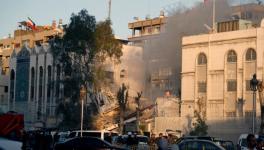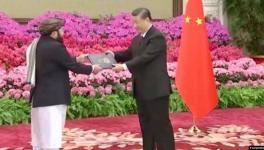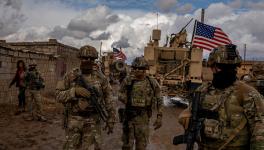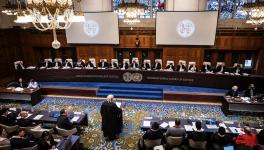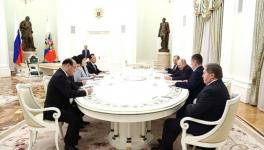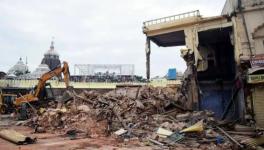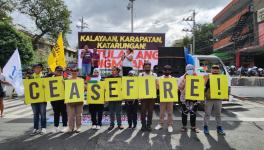No-State Solution Becomes More and More Real as Israel’s Permanent Nakba Continues
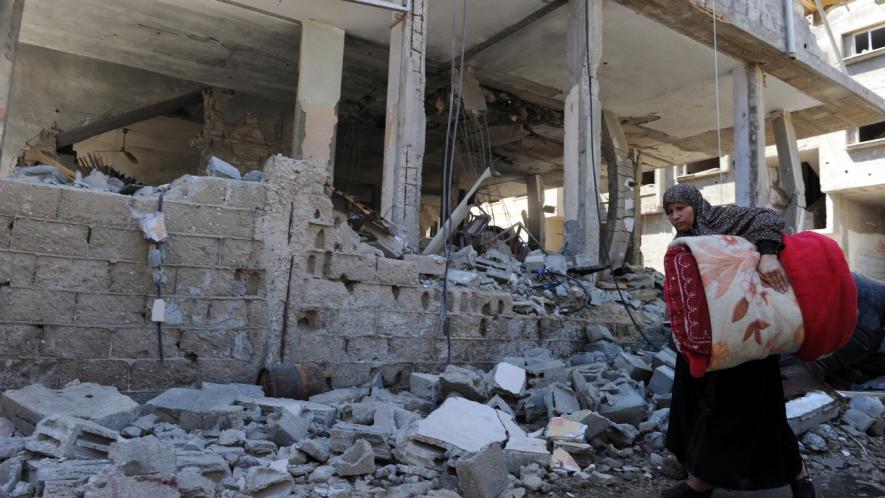
File Photo (Flickr)
In 1948, the Syrian historian Constantin Zurayk used the Arabic word Nakba (Catastrophe) to refer to the forced removal of Palestinians from their lands and homes by the newly formed Israeli state (in his August 1948 book, Ma’na al-Nakba or The Meaning of the Nakba).
A decade ago, in Beirut, I met with the Lebanese novelist Elias Khoury—then editor of the Arabic-language Journal of Palestinian Studies, who told me that the Nakba of 1948 was not an event but part of a process. “What we have is a Permanent Nakba, which means that this catastrophe has been continuous for the Palestinians,” he said.
Since 1948, Palestinian political movements and intellectuals have argued that the logic of the Israeli state has been to expel the Palestinians from the region between the River Jordan and the Mediterranean Sea. This policy of expulsion to create an ethno-religious Jewish State of Israel is what Khoury meant by the Permanent Nakba.
On November 11, 2023, Israel’s Agriculture Minister Avi Dichter said something startling to the press. “We are now rolling out the Gaza Nakba,” he said. “Gaza Nakba 2023. That’s how it’ll end,” said this former director of Israel’s internal security service Shin Bet.
In the first week of November, Israel’s Heritage Minister Amihai Eliyahu was on Radio Kol BaRama, whose interviewer ruminated about dropping “some kind of nuclear bomb on all of Gaza, flattening them, eliminating everybody there.” Eliyahu replied, “That’s one way. The second way is to work out what’s important to them, what scares them, what deters them… They’re not scared of death.” Israel, the minister said, should retake all of Gaza. What about the Palestinians? “They can go to Ireland or deserts,” he said. “The monsters in Gaza should find a solution by themselves.”
This language of annihilation and dehumanisation has become normal among the cabinet of Israeli Prime Minister Benjamin Netanyahu. Netanyahu suspended Eliyahu from his cabinet, but he did not rebuke his Defense Minister Yoav Gallant who called Palestinians “human animals.” This is the broad attitude of the Israeli high officials, who are now on record with this kind of language.
Israel’s army has advanced its execution of the “Gaza Nakba.” In the early stage of the attack, Israel told Palestinian civilians to move south within the Strip, along Salah al-Din Road, the north-south axis in this 40-kilometre-long area of Palestine that holds 2.3 million Palestinians.
The Israelis said that they would largely attack northern Gaza, particularly Gaza City. Around 1.5 million Palestinians moved from the northern part of Gaza to the south, the Israelis having told them repeatedly that this would be a safe zone. Those who stayed experienced a level of bombardment not seen in Gaza in the past, which has been pummeled by the Israelis on a punctual basis since 2006 (the current war including deadly air strikes against highly congested refugee camps, such as Jabalia).
In late November, five weeks into their brutal bombing in the north, Israel aircraft intensified the bombing of Gaza’s second-largest city, Khan Younis, and began ground operations in the areas where they had told civilians to take shelter. By the first week of December, Israeli tanks surrounded Khan Younis, and Israeli aircraft began to bomb small towns in the southern part of Gaza. Having pushed 1.8 Palestinians into the south, the Israelis now began to bomb that part of Gaza.
Meanwhile, Israel’s refusal to allow sufficient humanitarian aid to enter Gaza meant that nine out of 10 Palestinians are living without food for days on end (some told the UN World Food Programme that they had not eaten in 10 days). This total war by Israel has pushed the majority of Palestinians in Gaza down toward the Egyptian border. Under cover of this war, the Israelis have also moved aggressively into the West Bank to deepen the Permanent Nakba in that part of the Occupied Palestinian Territory.
As early as October 18, long before the Israeli forces moved toward Khan Younis, the Israel military tweeted that it “orders Gaza residents to move to the humanitarian zone in the area of al-Mawasi.” Three days later, the Israeli military said that the Palestinians must move “south of Wadi Gaza” and go to the “humanitarian area in Mawasi.” Those who went to this small enclave (3.3 square miles) found it without any services—including no internet—and found that even here the Israelis were firing their weapons nearby.
Mohammed Ghanem, who had lived near al-Shifa Hospital in northern Gaza, said that al-Mawasi was “neither humane nor safe.” Palestinians in southern Gaza now hope that they can get out before the Israeli bombs find them. The death toll is now in excess of 18,000 dead.
As one Palestinian friend wrote in a text, “If we do not leave our homes and go into exile, we will get killed here.” He sent this text just when confirmation arrived that more Palestinians have been pushed out of their homes and killed since October 7 than in the Nakba of 1948. “This is the Second Nakba,” he said to me from near the border between Gaza and Egypt.
A Vote for Annihilation
The ghastly Israeli attack on the Palestinians of Gaza provoked a call for a ceasefire from the second week of October. Israel’s immense firepower—provided by Western countries (especially the United Kingdom and the United States)—was used indiscriminately against a people who live in congested areas of Gaza.
Images of that violence flooded social media and even the broadcast news, which could not ignore what was happening. These images overcame all the attempts by the Israeli government and its Western backers to justify their actions. Tens of millions of people joined various forms of protests across the world, but significantly in the Western states that back Israel, bravely confronting governments that tried to portray their solidarity with the Palestinians—unsuccessfully—as antisemitism.
This attack was a cynical attempt to use the actual and horrible existence of antisemitism to malign the protests. It did not work. The call for a full-scale ceasefire increased, putting pressure on governments around the world to act.
On December 8, 2023, the United Arab Emirates (UAE) put a “brief, simple, and crucial” resolution for a ceasefire (the words are from UAE ambassador to the UN Mohamed Issa Abushahab). UN Secretary-General António Guterres invoked Article 99 of the Charter, which allows him to underscore the importance of an event through “preventative diplomacy” (the article has only been used three times previously, over the conflicts in the Republic of Congo in 1960, Iran in 1979, and Lebanon in 1989).
Almost a hundred member states of the UN backed the UAE resolution. “The people of Gaza are being told to move like human pinballs—ricocheting between ever-smaller slivers of the south, without any of the basics for survival,” Guterres told the UN Security Council. “Nowhere in Gaza is safe.” Thirteen members of the Security Council voted for it, including France, while the United Kingdom abstained. Only U.S. Deputy Ambassador Robert Wood raised his hand to veto the resolution.
Four days later, on December 12, the Egyptians tabled much the same resolution in the UN General Assembly, where Assembly President Dennis Francis (of Trinidad and Tobago) said, “We have one singular priority—only one—to save lives. Stop this violence now.” The vote was overwhelming: 153 countries voted for the resolution, 10 voted against it, and 23 abstained.
It is instructive to see which countries voted against the ceasefire: Austria, Czechia, Guatemala, Israel, Liberia, Micronesia, Nauru, Papua New Guinea, Paraguay, and the United States. Many European countries—from Bulgaria to the United Kingdom—abstained. But matters are complex. Even Ukraine did not vote with Israel on this resolution. They abstained.
The US veto in the Security Council and the votes against in the General Assembly are effectively votes for the Permanent Nakba of the Palestinian people, the No-State Solution. At least, that is how they will be read across the world, not only in al-Mawasi, as the bombs get closer, but also in the demonstrations from New York to Jakarta.
Vijay Prashad is an Indian historian, editor, and journalist. He is a writing fellow and chief correspondent at Globetrotter. He is an editor of LeftWord Books and the director of Tricontinental: Institute for Social Research. The views are personal.
This article was produced by Globetrotter.
Get the latest reports & analysis with people's perspective on Protests, movements & deep analytical videos, discussions of the current affairs in your Telegram app. Subscribe to NewsClick's Telegram channel & get Real-Time updates on stories, as they get published on our website.










